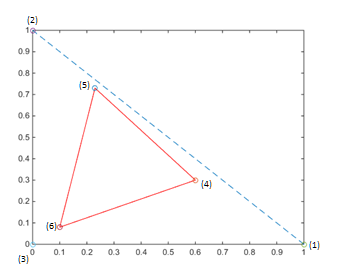m |
|||
| Line 11: | Line 11: | ||
---- | ---- | ||
===Solution 1=== | ===Solution 1=== | ||
| − | |||
| − | b) | + | a) <math>E\left[Y_x\right] = \lambda_x</math> |
| + | |||
| + | b) Because the rate of absorption is proportional to the number of photons and the density of the material, so the attenuation of photons obeys the following equation | ||
| + | |||
<math> | <math> | ||
| − | + | \frac{d\lambda_x}{dx} = -\mu(x)\lambda_x | |
| − | + | </math> | |
| − | + | c) Solve the differential equation in b), we have | |
| − | + | ||
| − | + | ||
| − | + | ||
| − | + | ||
| − | + | ||
| − | + | ||
| − | + | ||
| − | + | ||
| − | + | ||
| − | + | ||
| − | + | ||
| − | + | ||
| − | + | ||
| − | + | ||
<math> | <math> | ||
| − | + | \lambda_x = \lambda_0e^{-\int^x_0\mu(t)dt} | |
| − | + | ||
| − | + | ||
| − | + | ||
| − | ( | + | |
| − | + | ||
| − | + | ||
| − | + | ||
</math> | </math> | ||
| − | + | d) So the integral of the density, <math>\int^T_0\mu(x)dx </math> can be written as | |
| − | + | ||
<math> | <math> | ||
| − | ( | + | \int^T_0\mu(x)dx = -\log\left(\frac{\lambda_T}{\lambda_0}\right\) |
</math> | </math> | ||
| − | |||
| − | |||
| − | e) | + | e) <math>\int^T_ \mu(x)dx \simeq -\log \left\( \frac{Y_T}{Y_0} \right\)</math> |
| + | |||
== Solution 2: == | == Solution 2: == | ||
Revision as of 15:50, 18 May 2017
Contents
ECE Ph.D. Qualifying Exam in Communication Networks Signal and Image processing (CS)
August 2014, Problem 1
- Problem 1 , 2
Solution 1
a) $ E\left[Y_x\right] = \lambda_x $
b) Because the rate of absorption is proportional to the number of photons and the density of the material, so the attenuation of photons obeys the following equation
$ \frac{d\lambda_x}{dx} = -\mu(x)\lambda_x $ c) Solve the differential equation in b), we have
$ \lambda_x = \lambda_0e^{-\int^x_0\mu(t)dt} $
d) So the integral of the density, $ \int^T_0\mu(x)dx $ can be written as $ \int^T_0\mu(x)dx = -\log\left(\frac{\lambda_T}{\lambda_0}\right\) $
e) $ \int^T_ \mu(x)dx \simeq -\log \left\( \frac{Y_T}{Y_0} \right\) $
Solution 2:
a) $ \frac{R}{255}^\alpha=r_{linear}\\ \Rightarrow \gamma=log_{\frac{R}{255}}{(R^{\alpha})}=\frac{ln{(R^{\alpha})}}{ln{\frac{R}{255}}}=\frac{\alpha{ln{R}}}{ln{R}-ln{255}} $
$ \gamma $ should be 1.
b)
$ P_r= \left( \begin{array}{ccc} a & b & c \\ d & e & f \\ g & h & i \end{array} \right) \left( \begin{array}{ccc} 1 \\ 0 \\ 0 \end{array} \right) = \left( \begin{array}{ccc} a \\ d \\ g \end{array} \right) \\ \Rightarrow x_r=\frac{a}{a+d+g} , y_r=\frac{d}{a+d+g} \\ P_g= \left( \begin{array}{ccc} a & b & c \\ d & e & f \\ g & h & i \end{array} \right) \left( \begin{array}{ccc} 0 \\ 1 \\ 0 \end{array} \right) = \left( \begin{array}{ccc} b \\ e \\ h \end{array} \right) \\ \Rightarrow x_g=\frac{b}{b+e+h} , y_g=\frac{e}{b+e+h} \\ P_b= \left( \begin{array}{ccc} a & b & c \\ d & e & f \\ g & h & i \end{array} \right) \left( \begin{array}{ccc} 0 \\ 0 \\ 1\end{array} \right) = \left( \begin{array}{ccc} c \\ f \\ i \end{array} \right) \\ \Rightarrow x_g=\frac{c}{c+f+i} , y_g=\frac{f}{c+f+i} $
c)
$ W= \left( \begin{array}{ccc} a & b & c \\ d & e & f \\ g & h & i \end{array} \right) \left( \begin{array}{ccc} 1 \\ 1 \\ 1\end{array} \right) = \left( \begin{array}{ccc} a+b+c \\ d+e+f \\ g+h+i \end{array} \right) \\ \Rightarrow x_g=\frac{a+b+c}{a+b+c+d+e+f+g+h+i} , y_g=\frac{d+e+f}{a+b+c+d+e+f+g+h+i} $
e) Gamma correction a quantization will create an effect of dynamic range compression for pixels with small values. This will create dark block of shadings in a gradient region instead of a smooth transition.


